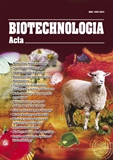ISSN 2410-7751 (Print)
ISSN 2410-776X (Online)

Biotechnologia Acta Т. 18, No. 2, 2025
P. 10-13 , Bibliography 5 , Engl.
UDC 577.112.7:616
doi: https://doi.org/10.15407/biotech18.02.010
THE MULTIFACETED ROLE OF ENDOPLASMIC RETICULUM STRESS IN THE REGULATION OF GENE EXPRESSION IN NORMAL ASTROCYTES AND GLIOBLASTOMA CELLS
O.V. Rudnytska, M.Y. Sliusar, Y.V. Kulish
Palladin Institute of Biochemistry of the National Academy of Sciences of Ukraine, Kyiv
Aim. To determine the role of the endoplasmic reticulum (ER) in regulating gene expression in normal astrocytes and glioblastoma cells under the application of carbon nanoparticles as anti-tumor agents.
Methods. Experiments were conducted on normal human astrocytes of the NHA/TS line and glioblastoma cell sublines U87MG. To study the impact of carbon nanoparticles, aqueous dispersions of graphene oxide (GO) and aqueous suspensions of single-walled carbon nanotubes (SWCNTs) were used. Methods of knockdown and silencing were applied to determine the role of the ERN1 signaling protein and its enzymatic activities. The measurement of mRNA and microRNA expression levels was carried out using RT-PCR.
Results. It was shown that the expression of serine biosynthesis genes depends on the enzymatic activities of the ERN1 signaling protein, which influences glioblastoma cell proliferation. Furthermore, the functional activity of ERN1 modifies the effects of hypoxia and nutrient deficiency on gene expression, which are significant factors in tumor growth. Comparison of the effects of SWCNTs and GO on normal astrocytes and glioblastoma cells demonstrated a more pronounced increase in studied gene expression levels in normal astrocytes than in glioblastoma cells.
Conclusions. Endoplasmic reticulum stress plays a vital role in regulating the expression of various regulatory genes in both normal and tumor cells. It also controls the effects of hypoxia and carbon nanoparticles on gene expression.
Keywords: ER stress, mRNA and microRNA expression, serine synthesis genes, hypoxia, carbon nanoparticles, glioblastoma cells, normal astrocytes
© Palladin Institute of Biochemistry of the National Academy of Sciences of Ukraine, 2025
References
1. Minchenko, O. H., Kulish, Y. V., Viletska, Y. M., Khita, O. O., Rudnytska, O. V., Kozynkevych,
H. E., Minchenko, D. O. (2024). The expression of DNAJB9 in normal human astrocytes is
more sensitive to nanographene oxide than in glioblastoma cells. Endocr. Regul., 58(4), 242–251.
https://doi.org/10.2478/enr-2024-0029.
2. Rudnytska, O. V., Kulish, Y. V., Khita, O. O., Minchenko, D. O., Tsymbal, D. O., Viletska, Y. M.,
Sliusar, M. Y., Trufanova, D. D., Minchenko, O. H. (2022). Exposure to nanographene oxide
induces gene expression dysregulation in normal human astrocytes. Endocr. Regul., 56(3), 216–226.
https://doi.org/10.2478/enr-2022-0023.
3. Rudnytska, O. V., Khita, O. O., Minchenko, D. O., Tsymbal, D. O., Yefimova, Y. V., Sliusar, M. Y.,
Minchenko, O. (2021). The low doses of SWCNTs affect the expression of proliferation and apoptosis
related genes in normal human astrocytes. Current research in toxicology, 2, 64–71. https://doi.
org/10.1016/j.crtox.2021.02.001.
4. Minchenko, D. O., Rudnytska, O. V., Khita, O. O., Kulish, Y. V., Viletska, Y. M., Halkin, O. V.,
Danilovskyi, S. V., Ratushna, O. O., Minchenko, O. H. (2023). Expression of DNAJB9 and some
other genes is more sensitive to SWCNTs in normal human astrocytes than glioblastoma cells.
Endocr. Regul., 57(1), 162–172. https://doi.org/10.2478/enr-2023-0020.
5. Minchenko, O. H., Sliusar, M. Y., Khikhlo, Y. P., Halkin, O. V., Viletska, Y. M., Khita, O. O.,
Minchenko, D. O. (2024). Knockdown of ERN1 disturbs the expression of phosphoserine
aminotransferase 1 and related genes in glioblastoma cells. Archives of biochemistry and biophysics,
759, 110104. https://doi.org/10.1016/j.abb.2024.110104.

